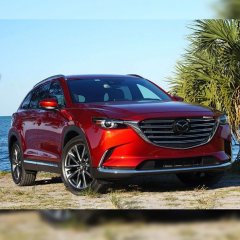Search the Community
Showing results for tags 'american cars'.
-
2018 Buick Regal GS first drive: The backroad Buick The new GS may not be track ready, but it’s an improved Regal by every performance measurementhttp://autoweek.com/article/car-reviews/2018-buick-regal-gs-first-drive-backroad-buick#ixzz58JgWnwXP One might assume the GS (Gran Sport) badge on the back of this Buick means serious business. After all, in the past, those two little letters signaled to everyone that specialized performance equipment was on board. The very first GS models back in the mid-1960s were hardcore. Buick described the Skylark GS as “a howitzer with windshield wipers.” And to be sure, the 2018 Regal GS is a meaningful improvement over the standard Regal Sportback. Yet, this one stops short of being a howitzer—or a true track-ready performance package. “It’s not really meant to drive on the other side of that wall, onto the racetrack,” Buick’s vehicle performance manager Mike Mueller mentions to us as we look out over Atlanta Motorsports Park’s road course in Dawsonville, Georgia. “We could have dialed up the GS but that’s not where we were trying to go. It’s not supposed to be a Camaro, Corvetteor high-performance Cadillac.” While the GS may not be a super sedan like Caddy’s V-Series monsters, engineers massaged the Regal in every way to improve its performance on the street. Under the hood, GM’s venerable 3.6-liter V6 takes the place of the 2.0-liter turbocharged four-cylinder in standard Regals. Here, that V6 makes 310 hp and 282 lb-ft of torque—a 60 hp and 26 lb-ft of torque bump over the four. Although the last Regal GS offered the option of a six-speed manual transmission up until 2016, this new one comes paired solely to GM’s nine-speed automatic. And all Regal GS models use a specifically-tuned version of the Regal’s twin-clutch all-wheel drive system. The chassis components as well as the strut front and five-link rear suspension systems are largely the same as the ones used on the more pedestrian Regal Sportback AWD models. The biggest change comes from the adoption of Continuous Damping Control (CDC) dampers from ZF at each corner. The firmness of these shocks can be adjusted through buttons on the center console. The front springs are unique here but only because the V6 carries an additional 40 pounds over the four-cylinder. Mueller says the stabilizer bars as well as chassis bushings remain unchanged. The GS does have Brembo brakes up front that measure 13.6-inches in diameter, up an inch over the standard Regal front brakes. Out back, the GS has 12.4-inch vented discs that are about an inch larger than the solid discs in the Regal. And to cover the new brakes, there are 19-inch wheels wrapped in 245/40R19 Continental Procontact TX tires. The GS carries some tasteful body mods, including more aggressive front and rear facias, side sills and a rear lip spoiler, and they make an already handsome car look a little tougher. On the inside, there are unique GS sill plates, a GS shifter and 14-way adjustable sport seats. Of course, this is still a Sportback. And that means there’s 31.5 cu-ft of cargo space with the rear seats up and a wagon-like 60.7 cu-ft. with them folded. So, this sporty machine is quite useful too. The Execution Slide into the new heated, cooled, massaging and heavily bolstered sport seats and its clear the GS is built to have some fun. The seats are fantastic and even include adjustable thigh support which was appreciated by my six-foot-four driving partner. Another welcome upgrade is the new partial TFT instrument cluster. It’s modern and much more befitting a car in this price class compared to the analog cluster in the normal Regal. Immediately ahead of the shifter are buttons labeled “sport” and “GS”. They are the key to unlocking driving enjoyment in this Buick. Press sport and the transmission will hold onto gears slightly longer and quicken the shifts. Sport mode also increases the heft of the steering, biases more torque to the rear axle and will dial up a firmer damping setting too. An individual mode allows the steering, dampers and all-wheel drive system responsiveness to be adjusted independently. Engage the “GS” mode and its basically Buick’s version of sport plus. The steering boost is dialed back even further, resulting in heavier, more substantial weighting. The transmission shifts are no quicker but the shift schedule is more aggressive, so it won’t upshift to a taller gear if you are hustling down a mountain road. The all-wheel drive system will bias even more of the engine’s torque to the rear axle here, and the damping from the CDC system becomes firmer still. What doesn’t change, no matter what mode you select, are the calibrations for ABS, traction control and stability control. You can turn off traction control by pressing a button on the dash once. And by holding that button down for a few seconds, the stability control can be dialed way back. But as one might imagine—it never goes away completely. “We don’t suddenly give you back 1970s handling,” says Mueller. “There’s always that last ditch effort from the system to keep you on the road.” One of the best things about the Regal GS is that it’s not overly hard-edged in anything that it does. There are plenty of sporty cars that can be a little too stiff and aggressive for daily driving, but Buick strikes an excellent balance here. In the default (normal) mode, the Regal drives just like a regular Sportback. The suspension is smooth and that nine-speed goes about its work in the background without anyone really noticing. The V6 is just fine here with plenty of torque to squirt through traffic. Driven hard, the Regal is quick. But this is the same basic V6 that lives under the hood of so many GM products—everything from Camaros to Colorados and even Buick’s own LaCrosse. So, when you really work this V6 hard, it doesn’t feel or sound particularly exciting, or special enough for a high-performance application Drive it up a set of switchbacks and the transmission’s preference for taller gears will have you pressing the sport or GS buttons. We toggled through all three modes (normal, sport and GS) and found that in almost every driving situation, we just left it in GS. The transmission calibration is excellent, dropping gears or holding onto them without going one gear too far or staying in a low gear too long. The heavier weighting of the steering in GS mode feels good on a mountain drive as well as in the city. On those twisty Georgia backroads the Regal GS was athletic and fun. The only reason to perhaps not have the GS in GS mode? Negotiating a field of Detroit-class potholes. Our $43,510 Regal GS was loaded. It carried the $945 Sights and Sounds package, which includes Buick’s navigation system HD Radio, and a Bose audio system. The $1,690 Driver Confidence Package pulls together all the safety tech like adaptive cruise control, lane keep assist, forward collision warning amongst others. The Appearance Package ($485) brings wireless phone charging and LED headlamps on board. Our metallic paint cost an additional $395 and the sport aluminum pedals are $175. The Takeaway The GS is certainly the Regal in Buick’s lineup we’d want parked in our own garage. It’s responsive and enjoyable on ribbons of twisty asphalt without compromising comfort—and that’s appealing. But there are of course others in the Buick’s competitive class -- performance German machinery that will bring a little more agility and a little more cache to the driving experience for a little more money. Still with all the options checked, the GS is a really good deal and easily the best Buick we’ve driven in years.
- 19 replies
-
- buick
- american cars
-
(and 2 more)
Tagged with:
-

Another American car brand bites the dust: Rust In Peace, Pontiac
Rigval posted a blog entry in MyAutoBlog
[extract] Pontiac is no more. After 84 years of producing Pontiacs, General Motors have ceased producing the brand famed for the GTO, Trans Am and the Firebird. It joins other GM brands like Geo, Saturn, Oldsmobile and Hummer in automobile heaven. Or hell, depending on how you think of the brand. I especially like the 1970s Trans Am or Firebird, complete with that Firebird that looks like a flaming chicken. Very 70-
- motoring news
- industry news
-
(and 2 more)
Tagged with:
-

Are American cars still bad? Dodge Journey vs Kia Sorento
Ragingbull posted a blog entry in MyAutoBlog
So I recently had the chance to take the Dodge Journey for a spin (review here). Nothing exciting I know but it left me slightly impressed with the overall quality of the car. Interior plastics were better than expected and the myriad of storage locales around the car was a delightful addition. So why did we hate American cars again? Bad plastics? Lousy and thirsty engines? Soft suspension setup? Someone needs to refresh my memory cos I've forgotten. The last American car I had the chance to drive was the Hummer H3 and boy did that leave me hugely impressed. So, for me, the Journey has cleanly lacquered and sealed in those sentiments. While driving it I kept comparing it to the Kia Sorento (review here). Although the Kia benefits from a far longer equipment list, leather seats and a much better designed interior, I couldn't help but appreciate how the Journey was a different animal altogether. Seats were good quality fabric seats. Steering was light, which should be the case in such a family mover don't you guys agree? The Sorento had an unnatural mechanical weighted steering which didn't put you in contact with the road at all. You've got so many storage locations and even a air-conditioned compartment above the glove compartment. The rims on the Journey were smaller than the Sorento though, which left an ugly gap between the tyres and the arches. Down to fuel economy though, the Journey does just a little worse than the Korean car. So why so much hate for the American again? Both cars are around the same price anyways. I personally would take the Journey for its far more practical uses...what would you guys take?-
- american cars
- dodge journey review
- (and 3 more)
